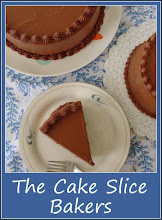The August 2010 Daring Bakers’ challenge was hosted by Elissa of 17 and Baking. For the first time, The Daring Bakers partnered with Sugar High Fridays for a co-event and Elissa was the gracious hostess of both. Using the theme of beurre noisette, or browned butter, Elissa chose to challenge Daring Bakers to make a pound cake to be used in either a Baked Alaska or in Ice Cream Petit Fours. The sources for Elissa’s challenge were Gourmet magazine and David Lebovitz’s “The Perfect Scoop”.
This month we were required to make a brown butter pound cake and some ice cream of our choice and turn it into either baked alaska or petit fours. I had never had frozen ice cream cake petit fours before and so this was my dessert of choice.
As we experimented with ice cream in last months Daring Bakers challenge I wanted to do something different this month. I remembered a recipe for instant banana ice cream that I read about a few months back and decided now would be the perfect time to test it out, especially as I had yet more overripe bananas in the fruit bowl! The method is surprisingly simple yet yields delicious results. You freeze chunks of banana and then blitz them (still frozen) in a food processor with a little yoghurt and syrup and within seconds – ta da – instant smooth and creamy frozen banana cream that has the taste and texture of ice cream! You can eat it straight out the bowl or freeze it for later. It’s ingenious and fantastically bananary, not to mention healthy. I really recommend you give it a go.
I was also pleased to try out the brown butter cake recipe we were given, as I’d never made one of these myself. It turned out very well and produced a very light, springy and golden coloured cake with a nutty overtone. I also added a mix of cinnamon, ginger and freshly grated nutmeg to mine which I thought would complement the nuttiness as well as the banana ice cream.
Everything was going well until it came to the glaze. Rather than use the recipe provided I decided to make a glaze I have done in the past for profiteroles. I’m not sure what happened but one minute I had smooth glossy sauce and then next it was too thick and gloopy. I used it anyway, but it refused to coat the petit fours properly so instead I just spooned some over the top and let it drizzle over the sides a bit. They still ended up looking pretty, but not the elegant sophisticated petit fours I was hoping for. As a result I’m not giving you the glaze recipe I made, but I have written the glaze recipe provided below for anyone who wants to make these. Note to self: sometimes things are best left un-meddled.
I loved the taste and texture of these little bites. The spiced nutty cake and banana ice cream were a great match and the glossy dark chocolate glaze left you with a rich cocoa taste that tasted delicious as it mingled with the melting banana cream.
Thanks Elissa for choosing such a great challenge. Click to see a list of my fellow Daring Bakers and what they did with their cake and ice cream.
Spiced Brown Butter Pound Cake & Instant Banana Ice Cream Petit Fours
Spiced Brown Butter Pound Cake
275g unsalted butter
200g plain flour
1 tsp baking powder
½ tsp salt
110g light brown sugar
75g caster sugar
4 large eggs
½ tsp vanilla extract
(I also added 1 tsp cinnamon, ½ tsp ginger and ¼ tsp nutmeg)
Method
Preheat the oven to 165C and put a rack in the center. Butter and flour a 9inch/23cm square pan.
Place the butter in a saucepan over medium heat. Brown the butter until the milk solids are a dark chocolate brown and the butter smells nutty – but you don’t want black and burnt. Pour into a shallow bowl and chill in the freezer until just congealed, 15-20 minutes.
Whisk together the flour, baking powder, salt (and spices if using).
Beat the cooled brown butter, light brown sugar, and caster sugar with an electric mixer until light and fluffy, about 2 minutes. Beat in the eggs one at a time, mixing well, and then the vanilla extract.
Stir in the flour mixture at low speed until just combined. Scrape the batter into the prepared pan. Smooth the top with a rubber spatula. Bake until golden brown on top and a toothpick inserted into the center comes out clean, about 25 minutes.
Cool in the pan for 10 minutes. Run a knife along the edge and invert right-side-up onto a cooling rack to cool completely.
Instant Banana Ice Cream
3 bananas
150g yoghurt
1 tbsp honey, glucose or golden syrup
Method
Ahead of time, peel the bananas and cut them into rough chunks. Place in a plastic bag and freeze them until solid.
Place the chunks of frozen banana in a food processor and blitz to break the bananas into smaller pieces. Add the yoghurt and honey/syrup and blitz again until smooth and creamy. (Adding the syrup helps prevent ice crystals from forming during freezing).
Eat straight away or spread the mixture into a clingfilm lined pan the same size as your cake, if making petit fours and freeze until firm.
Assembly of Ice Cream Petit Fours
Line a 9inch/23cm pan with clingfilm, so that no sides of the pan are exposed and there is some extra plastic wrap hanging off the sides.
Take the brown butter pound cake and level the top with a serrated knife if needed. Then cut the cake in half horizontally to form two thin layers. Place one of these layers into the base of the lined pan.
Remove the ice cream from the freezer, lift it out of the pan with the help of the cling film and place it on top of the base layer of cake. Top with the second layer of cake, wrap well in clingfilm and return to the freezer overnight.
Make the chocolate glaze (your own recipe or see below)
While the glaze cools, remove the ice cream cake from the freezer and use a sharp knife to cut it into 4cm squares. You can trim the edges first if needed.
Place the ice cream cake squares on tray lined with a sheet of greaseproof to help clean up later.
Glaze the petit fours one at a time by dipping/coating them in the chocolate glaze. Use a spoon or fork to help you. Place a petit four on the tines of a fork and spoon chocolate glaze over it.
Place the petit fours on the greaseproof lined tray and freezer for an hour. Allow to st at room temperature for 5-10 minutes before serving.
Vanilla Ice Cream Recipe Provided
250ml whole milk
A pinch of salt
165g caster sugar
1 vanilla bean, split lengthwise or 2tsp vanilla extract
500ml double cream
5 large egg yolks
1-3 tsp vanilla extract (see method)
Method
1. Heat the milk, salt, and sugar in a medium saucepan until the liquid steams. Scrape out the seeds of the vanilla bean and add to the milk, along with the bean pod. Cover, remove from heat, and let infuse for an hour. (If you do not have a vanilla bean, simply heat the milk, salt, and sugar in a medium saucepan until the liquid steams, then let cool to room temperature.)
2. Set up an ice bath by placing a 2 litre bowl inside a large bowl partially filled with water and ice. Put a strainer on top of the smaller bowl and pour in the cream.
3. In another bowl, lightly beat the egg yolks together. Reheat the milk in the medium saucepan until warmed, and then gradually pour a quarter of the warmed milk into the yolks, constantly whisking to keep the eggs from scrambling. Once the yolks are warmed, scrape the yolk and milk mixture back into the saucepan of warmed milk and cook over low heat. Stir constantly and scrape the bottom with a spatula until the mixture thickens into a custard which thinly coats the back of the spatula.
4. Strain the custard into the cream and stir the mixture until cooled. Add the vanilla extract (1 tsp if you are using a vanilla bean or 3 tsp if you are not using a vanilla bean) and refrigerate until thoroughly chilled, preferably overnight.
5. Remove the vanilla bean and freeze in an ice cream maker. If you don’t have an ice cream maker, you can make it without a machine. Click to see instructions from David Lebovitz.
Chocolate Glaze Recipe Provided
250g dark chocolate, finely chopped
250ml double cream
1½ tbsp light corn syrup/golden syrup
2 tsp vanilla extract
Method
Stir the cream and syrup in a small saucepan over medium heat until it comes to a boil. Remove from heat and add the dark chocolate. Let sit 30 seconds, then stir to completely melt the chocolate. Stir in the vanilla and let cool until tepid before glazing the petit fours.
Blueberry Cake - Incredibly Moist
13 hours ago















































